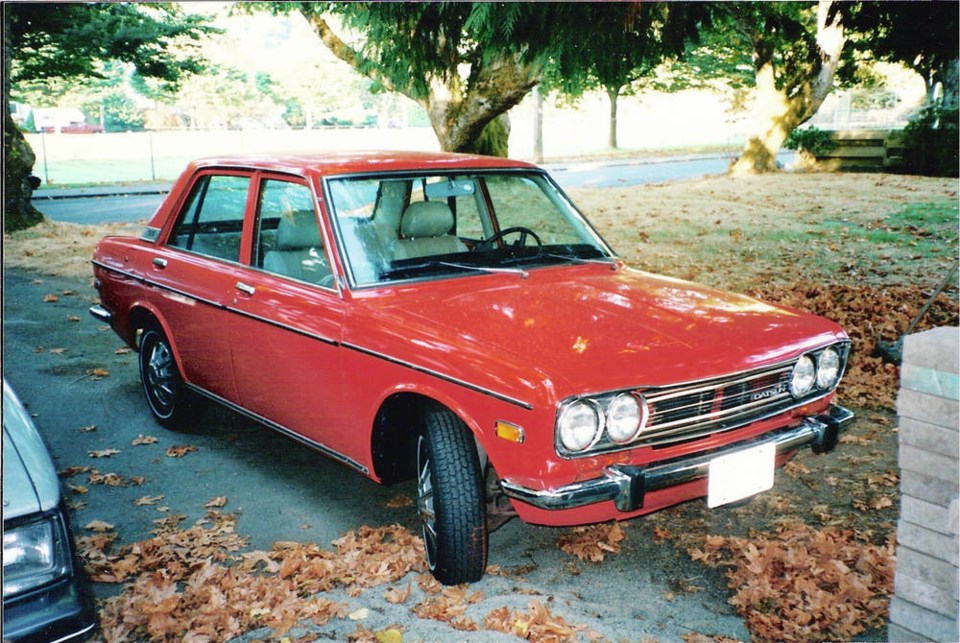The Japanese automotive industry was anxious to get into car building following the Second World War. After repairing their war-damaged plants many companies began by assembling models like English Austin A40s, Hillman Minxes and French Renaults under licence. By the mid-1950s they were gaining the expertise and confidence to engineer their own.
Japan wanted to export its cars but the first Toyota Toyopets and Datsun 1000s they sent to the United States West Coast in the late 1950s were not very well suited to North American driving. So Japanese engineers came to California, took detailed notes on North American requirements and went home to improve their products.
Within a decade they were building cars capable of challenging the all-conquering Volkswagen. Two of their best were Toyota’s Corolla and Nissan Motor Co.’s Datsun 510.
When the 510 was introduced in 1967 as a 1968 model it sent a signal that Japan was quickly developing the expertise to compete with the world. The styling, although angular, was straightforward, well proportioned and attractive. The interior was comfortable but not lavish and it came as a four-door, five passenger sedan or station wagon.
Its technical features were progressive enough to demonstrate how far Japan had come. The engineering was so advanced for an economy car that some referred to it as the poor man’s BMW 2002, a car that was introduced to North America in the same year.
But the 510 was a $2000 car and the 2002 close to $3000. It was an example of the competitive pricing and high value-for-money that would become a hallmark of Japanese cars.
The 510 sedan’s technical features included four-wheel independent suspension, a progressive feature for a front engine car in this class. It was comprised of MacPherson struts in front and semi-trailing arms with coil springs at the rear, a la BMW, Mercedes and others. For packaging reasons, the wagon had a solid rear axle on longitudinal leaf springs. Brakes were disc front and drum rear.
Under the hood was an all-new 1,595 cc (97.3 cu in.) oversquare (bore and stroke 83.0 X 73.3 mm [3.27 X 2.90 in.]) inline four cylinder engine with chain-driven single overhead camshaft and sturdy five main bearing crankshaft. It had a single carburetor and drove the rear wheels through an all-synchromesh, floor-shift, four-speed manual transmission or optional three-speed automatic
Unit construction gave the 510 a spacious interior and kept weight to a reasonable 966 kg (2,130 lb). A welcome feature was flow-through ventilation with fresh air entering the cowl vent ahead of the windshield and exiting through small grilles in the rear pillars.
The 510 was quite compact with a 2,421 mm (95.3 in.) wheelbase and 4,120 mm (162.2 in.) overall length. These dimensions were close to the sales-leading Volkswagen Beetle, although the 510 was some 104 kg (230 lb) heavier.
According to Road & Track (3/68) the 96 horsepower 1.6 litre four accelerated the 510 from zero to 97 km/h (60 mph) in 13.5 seconds and to a top speed of 158 km/h (98 mph). This was excellent small car performance in an era when the popular Volkswagen Beetle took over 22 seconds to 97 (60) and could only reach 126 km/h (78 mph).
In summarizing, R&T’s testers concluded that the 510 “offers an advanced specification for its class and a lot of value at its price.”
It soon became apparent that the 510’s combination of toughness,, performance, handling and technology — overhead cam engine, all independent suspension, fully synchronized four-speed and front disc brakes — were an ideal foundation for a competition car.
The 510 responded well to modification and was soon winning rallies and sedan races across the U.S. and Canada, with no less a celebrity than actor Paul Newman campaigning one. To help the cause, Datsun offered a high-performance 510 SSS competition version.
Nissan Motor Co. built the original 510 for five years and produced over 350,000 of them. The name was resurrected in 1978 by a new 510 but it seemed to lack the crispness and appeal of the original.
The first Datsun 510 and cars like the Corolla and Honda Civic and Accord signalled to the world that the Japanese were becoming a force to be reckoned with.
Unfortunately for Detroit it didn’t realize or didn’t initially heed the warning, but two oil crises in the 1970s that thrust small economical cars to the fore soon proved the seriousness of the threat.
Japan appeared poised to do to the automobile market what it had done in motorcycles, cameras and portable radios. The arrival of cars like the Datsun 510 helped consolidate their success.
That first Datsun 510 is fondly remembered by former owners, whether racers, rallyists or just regular commuters, as an economical and durable car.



